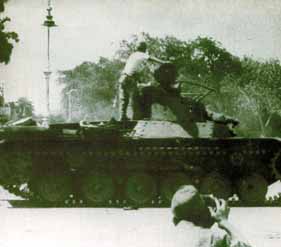 Left:
Marmon Harrington Mark 2 (South African) used in Malaya in 1941-42.
Left:
Marmon Harrington Mark 2 (South African) used in Malaya in 1941-42.
Before the first SAF AFVs ever operate in Singapore, many of its predecessor have already taken part in the great war 30 years earlier on this land. The objective of this page is to investigate the various types of AFVs operating in Singapore during WW2 and the immediate post war period. The list is by no means exhaustive and new information will be uploaded when and where avaliable.
Marmon-Harringtons Mark 2 Armoured Car
 Left:
Marmon Harrington Mark 2 (South African) used in Malaya in 1941-42.
Left:
Marmon Harrington Mark 2 (South African) used in Malaya in 1941-42.
Thirty such armoured cars were issued from the ordnance depot in Singapore on 8 December 1941 to the 3rd Cavalry of the 11th Indian Division, III Indian Corps. These four-wheeled cars were armed with a Vickers machine gun and a mounting for a .50 in. Boys anti-tank rifle. After failing to impede the Japanese progress on mainland Malaya, the regiment withdrew with other British forces into Singapore; crossing the causeway into the island at 5.30 am on 31 January 1942 with the remaining eight armoured cars. A gap was blown in the causeway at 7.30 am and it was subsequently mined and blocked. The remnants of the regiment surrendered on 14 February 1942 with all surviving vehicles handed over to the Japanese.
Carden Lloyd tankettes
 Left:
Carden Lloyd tankette used by 100th Indian Squadron in Malaya 1941-42.
Left:
Carden Lloyd tankette used by 100th Indian Squadron in Malaya 1941-42.
The only other British armour avaliable in Malaya was nine such tankettes which had been shipped from the Middle East. They were used by the 100th Independent Light Tank Squadron formed six months earlier. The squadron arrived in Singapore on 27 January 1942 and collected the nine obsolete tanks. Having seen much service in the desert, the two man tankettes needed repairs and overhaul which were not permitted due to lack of facilities and time. This Indian squadron had exactly three days of training in handling the "new" equipment before being placed under the command of the 3rd Cavalry for disposal. The squadron was neither ever fully operational, nor did it get a chance to get close to the enemy. The tankettes never got within firing range of the Japanese ans surrendered with the rest of the garrison on 14 February 1942.
Japanese Tanks and Tankettes
 |
Left: Japanese Type 97 CHI-HA
in Singapore city.
By 1942, the Type 97 CHI-HA medium tank and the Type 95 HA-GO light tank had equipped some independent tank regiment and those in the armoured divisions. These tanks were particularly sucessful in China and Malaya where individual tank companies were handled daringly in co-operation with infantry and engineers to break the defence at Jitra and on Slim River. The Slim River disaster resulted in the loss of Central Malaya and reduced the time that could have been gained and utilised for improving the defences of Singapore |
| Right: Type 97 medium tanks
drives down Orchard Road, Singapore.
In a sharp contrast to the British, the Japanese was able to appreciate the capability and potential of tanks in jungle warfare and where possible, tanks were used to spearhead the rapid advance down the Malayan Peninsula towards Singapore island. |
 |
 |
Left: A column of Japanese light
tank/tankette of unknown type in Singapore. Some source which had used
the photo claims that the tankettes were crossing the causeway (presumably
the repaired section as the original causeway was gravel-paved). (Copyright
Keystone)
Numerous other types of light tanks and tankettes (such as the Type 92 Light tank, Type 94 Tankette or Type 97 tankette) might also have been used in the Malayan Campaign too. The author has yet to do a detailed study into the actual types that were ever in Singapore and will do so in the near future. The AFVs in the photo on the left might be Type 94 tankettes as the Type 92 has a 3-men crew. Judging from the size of the vehicle, it can only accommodate a 2-men crew & hence the Type 94 is a more probable suggestion. Comments? |
M4 Sherman Medium Tank
 A
Duplex-drive M4 Sherman supplied to the British forces, rumbles ashore
at Singapore in 1945 from an American-built LST. (Imperial War Museum,
London)
A
Duplex-drive M4 Sherman supplied to the British forces, rumbles ashore
at Singapore in 1945 from an American-built LST. (Imperial War Museum,
London)
During the course of WW2, US supplied her allies with numerous war materials, including the M4 Sherman tanks. While most British-origin tanks operated in the European theater, the US-supplied ones were used to re-equipped the depleted forces in the Eastern theater. After the capture of Rangoon, the Sherman equipped 11th PAVO Cavalry returned to India with 254 Tank Brigade. The unit was however, moved to Singapore from Ahmednagar in August 1945 to perform garrison duties until its transfer to Java in December.
If you have any photos, comments or extra information which you will like to share, please forward them using this link. Full credits will be given.
[ History
& Organisation | Ex
Wallaby 1993 | Weapons
& Equipment | Photo
Archive ]
[ Links
| Bibliography
| Disclaimer | Acknowledgements
| Announcements
| Main
]